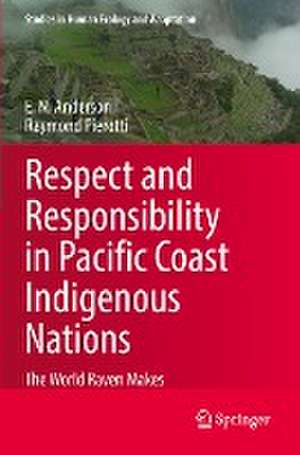Respect and Responsibility in Pacific Coast Indigenous Nations: The World Raven Makes: Studies in Human Ecology and Adaptation, cartea 13
Autor E. N. Anderson, Raymond Pierottien Limba Engleză Paperback – 14 oct 2023
| Toate formatele și edițiile | Preț | Express |
|---|---|---|
| Paperback (1) | 642.18 lei 6-8 săpt. | |
| Springer International Publishing – 14 oct 2023 | 642.18 lei 6-8 săpt. | |
| Hardback (1) | 648.42 lei 6-8 săpt. | |
| Springer International Publishing – 13 oct 2022 | 648.42 lei 6-8 săpt. |
Preț: 642.18 lei
Preț vechi: 755.51 lei
-15% Nou
Puncte Express: 963
Preț estimativ în valută:
122.88€ • 128.56$ • 102.08£
122.88€ • 128.56$ • 102.08£
Carte tipărită la comandă
Livrare economică 03-17 aprilie
Preluare comenzi: 021 569.72.76
Specificații
ISBN-13: 9783031155888
ISBN-10: 3031155882
Pagini: 316
Ilustrații: XIV, 316 p. 1 illus.
Dimensiuni: 155 x 235 mm
Greutate: 0.47 kg
Ediția:1st ed. 2022
Editura: Springer International Publishing
Colecția Springer
Seria Studies in Human Ecology and Adaptation
Locul publicării:Cham, Switzerland
ISBN-10: 3031155882
Pagini: 316
Ilustrații: XIV, 316 p. 1 illus.
Dimensiuni: 155 x 235 mm
Greutate: 0.47 kg
Ediția:1st ed. 2022
Editura: Springer International Publishing
Colecția Springer
Seria Studies in Human Ecology and Adaptation
Locul publicării:Cham, Switzerland
Cuprins
- 1. Commons and Management. - 2. Looking to the Sea: Economics and Ecology in the Pacific Northwest. - 3. Looking to the Land: Terrestrial Ecology. - 4. Traditional Cultural Areas. - 5. Social and Cultural-Ecological Dynamics. - 6. Traditional Resource Management. - 7. White Settler Contact and Its Consequences. - 8. The Ideology Behind It All. - 9. Animism and Rationality: North vs “West”. - 10. Respect and Its Corollaries. - 11. Teachings and Stories. - 12. The Visual Art. - 13. Conclusions. - 14. Appendix 1: Indigenous California. - 15. Appendix 2: Wider Connections. - 16. Appendix 3: The “Wasteful” Native Debunked.
Notă biografică
E. N. Anderson is Professor Emeritus of Anthropology, University of California, Riverside. He received a B.A. in anthropology from Harvard College in 1962 and a Ph.D. in anthropology from the University of California, Berkeley in 1967. He taught at Riverside from 1966-2006, when he became emeritus. He has worked on cultural anthropology, cultural ecology, ethnobiology, and food and nutrition in China, Pacific Northwest, and the Yucatan (Yucatec Maya). He was President of the Society of Ethnobiology from 2007-2009 and received the Distinguished Ethnobiologist Award from it in 2013 for his outstanding contributions to the field. He has been a member of the Editorial Board of the Journal of Ethnobiology, Human Ecology, and the Journal of Ecological Anthropology. He has done field work in Hong Kong, Malaysia, British Columbia, and Quintana Roo.Raymond Pierotti is Associate Professor at the Department of Ecology and Evolutionary Biology (Indigenous Nations Studies), University of Kansas. Dr. Ray Pierotti's research investigates the evolutionary biology of vertebrates with male parental care and socially monogamous breeding systems. He collects data on individual variation in behavioral and ecological aspects of parental care. His primary research question is how an individual organism becomes successful at reproduction and contributes to future generations.
Textul de pe ultima copertă
This book examines ways of conserving, managing, and interacting with plant and animal resources by Native American cultural groups of the Pacific Coast of North America, from Alaska to California. These practices helped them maintain and restore ecological balance for thousands of years. Building upon the authors’ and others’ previous works, the book brings in perspectives from ethnography and marine evolutionary ecology. The core of the book consists of Native American testimony: myths, tales, speeches, and other texts, which are treated from an ecological viewpoint. The focus on animals and in-depth research on stories, especially early recordings of texts, set this book apart. The book is divided into two parts, covering the Northwest Coast, and California. It then follows the division in lifestyle between groups dependent largely on fish and largely on seed crops. It discusses how the survival of these cultures functions in the contemporary world, as First Nations demand recognition and restoration of their ancestral rights and resource management practices.
Caracteristici
Analyses the indigenous natural resource management of Native Americans of the Pacific Coast Contrasts these practices and ideology with those of settler practices that have led to biodiversity loss Discusses the concept of myth as an ecological regulator












